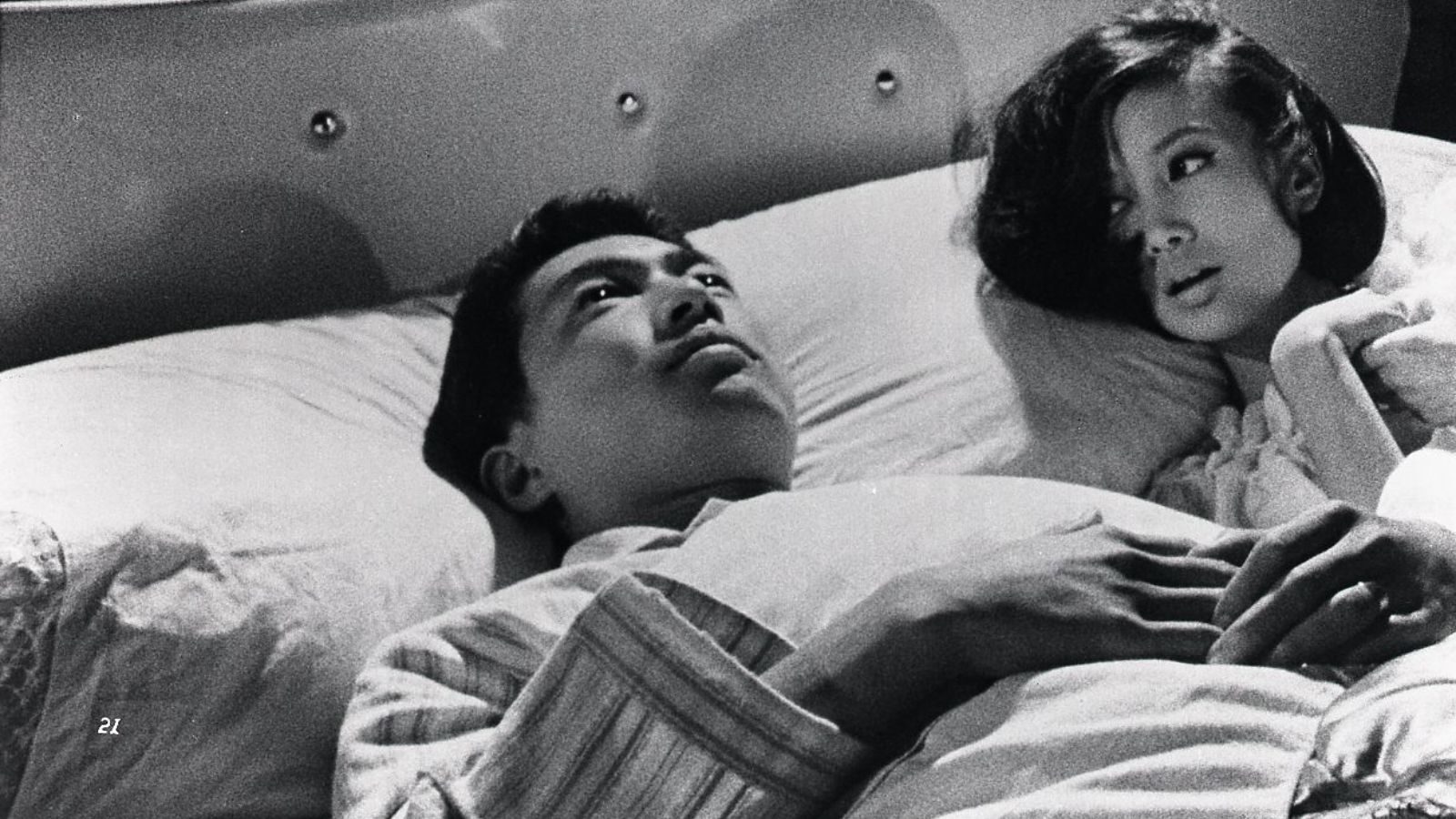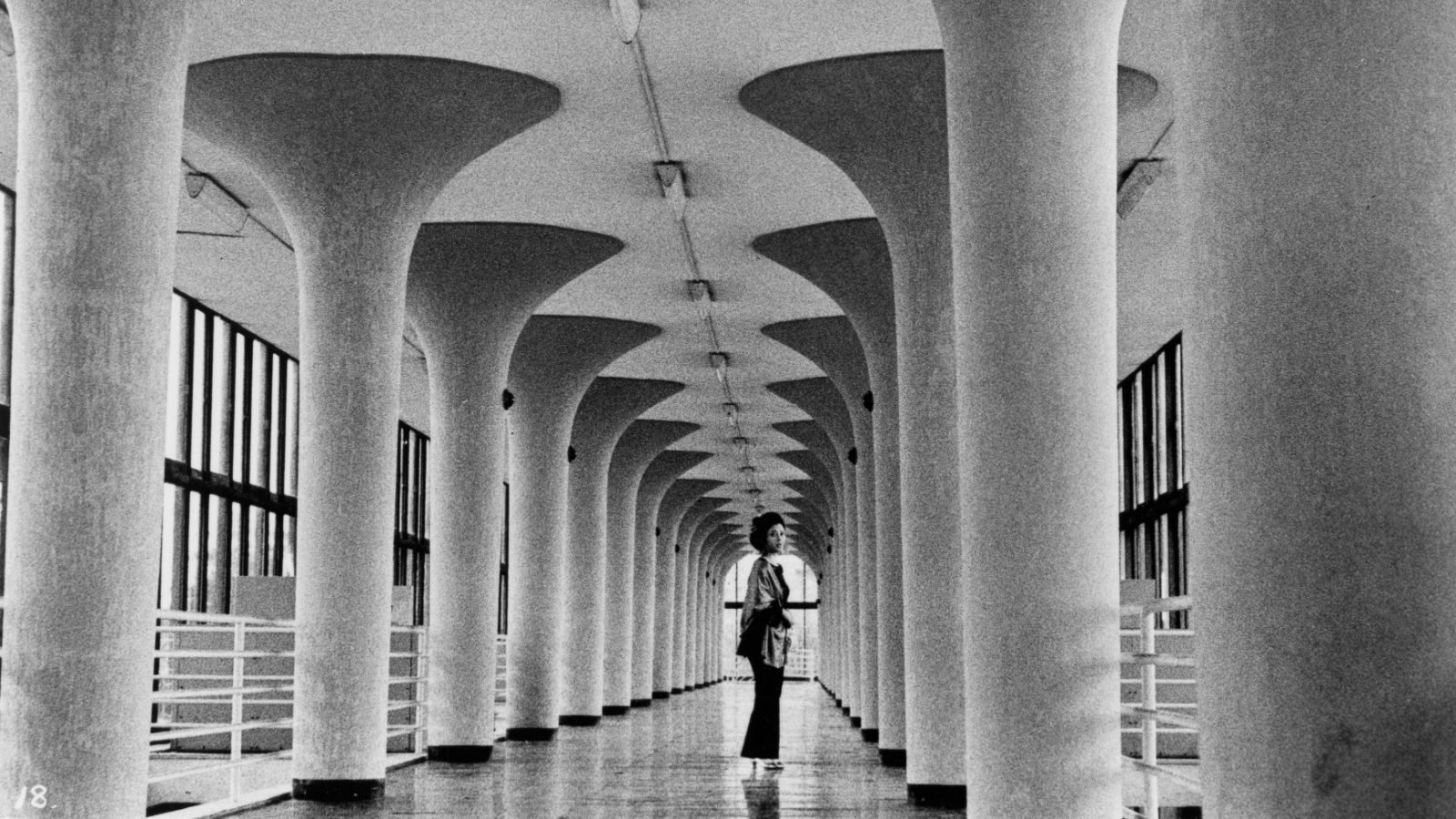“Cinema is drama, not accident.”
– Yasujiro Ozu, speaking to Kiju Yoshida from his death bed in 1963
The enigmatic phrase, imparted just three years into Yoshida’s career, would continue to rattle in his head for decades, so much so that nearly 40 years later he would write Ozu’s Anti Cinema, a book reckoning with the late director’s complex legacy and Yoshida’s own film practice. Like the uneasily (a)symmetrical quote from the old master, Yoshida’s films are defined by artifice, affirmation, and negation—an insistent mathematical quality that undergirds profoundly human stories of sex and politics.
This week, Film at Lincoln Center presents a retrospective of Yoshishige (aka Kiju) Yoshida (1933–2022) in collaboration with the Japan Foundation and in cooperation with the National Film Archive of Japan. Programmed by Dan Sullivan, the series features 16 of Yoshida’s films, spanning his career, nearly all of them on imported 35mm prints. Yoshida is a central figure of the Japanese New Wave, but lacks the name recognition of contemporaries like Nagisa Oshima, Masahiro Shinoda, Hiroshi Teshigahara, and Shohei Imamura.
Though much can be said about Yoshida’s long and varied career, the most singular aspect of his style is his unusual eye for compositions, which stand out even in the midst of one of the most formally adventurous eras of filmmaking. His images are most easily defined in the negative: anti-harmony, anti-symmetry, anti-continuity. Frequently in his cubist frames, a wall or object will cover a vast portion of the frame, with characters shoved into the periphery. Actors are shot from the neck up with way too much headspace. Or they are shown only in fragmented reflections, or in extreme wide shots—shrunken to the size of ants against a gaping landscape or a black void. And the camera moves in strange ways, too, eager to find a new foreground object to reframe heads or bodies, or to spin in seemingly motiveless circles. Because of his constant rewriting of rules, you couldn’t reduce Yoshida’s shots to a formula, or recreate them with an algorithm, but you could almost certainly pick one out of a lineup.
In an interview with Cahiers du Cinéma in 1970, Yoshida divided his own career into three phases–the first being his start with with the Shochiku Studio, the second his semi-independent period when he made a series of films funded outside of (albeit distributed within) the studio system, and the third his complete break with the studio system, starting with Eros + Massacre in 1969. With hindsight, a long fourth phase could be added, following his announced retirement after Coup d’etat (1973), during which he made three more features over the course of 30 years, as well as TV documentaries about Ozu, art, and baseball.
Like contemporaries Oshima, Imamura, and Shinoda, Yoshida spent his early years in the studio system. In postwar Japan, studios were notoriously commercial and risk-averse, but in competition with the rise of television, they began giving younger directors a chance in the early 1960s. After cutting his teeth as an assistant director, Yoshida directed Good-for-Nothing (1960), Blood Is Dry (1960), and Bitter End of a Sweet Night (1961), early works elevated by satirical critiques of Japanese society and germs of the radical formalism that would continue to metastasize in his later work.

From the start, Yoshida and his peers consciously modeled their films in opposition to the maverick directors of the prior generation like Akira Kurosawa and Keisuke Kinoshita, whose films they believed represented a faith in “mankind,” reflecting a postwar, American-imported idea of ahistorical humanism. Yoshida believed contemporary Japanese cinema needed to address man in “such-and-such a situation,” a materialist, anti-humanist stance that seeped its way into his otherwise commercial studio efforts.
Soon enough, Shockiku began to feel that their new crop of young directors’ films were too dangerous—both too formally progressive and dealing too directly with issues of the working class. In the second period, his relationship with Shockiku became more fraught. His biggest success of this era was Akitsu Springs (1962), a melodrama most notable for starring Mariko Okada (her 100th film role), two years before they married, marking the beginning of a 40-year collaboration. But despite the goodwill earned by Akitsu Springs, Shockiku continued to meddle with Yoshida’s next efforts, the more overtly political 18 Who Cause a Storm (1963) and Escape from Japan (1964), causing him to leave the studio in 1964. He collaborated with a newspaper to make his first independent film, A Story Written with Water (1965).
Free of the studio system, A Story Written with Water is the first Yoshida movie that feels completely his own, overflowing with the narrative and formal experimentation that bubbled at the edges of his earlier work. The title could be said to describe water’s frequent plot appearances, but equally seems to reflect the fluidity of Yoshida’s form, in which the tides of present drama, past recollections, and fantasy flow associatively into a frothy Oedipal fever dream between the young salaryman Shizuo (Yasunori Irikawa); his vivacious fiancé, Yumiko (Ruriko Asaoka); and his mother, Shizuka (Mariko Okada). Yoshida seamlessly blends Shizuo’s adolescent flashbacks (in which Okada appears to be the same age, her beauty seemingly frozen in his psyche) with present-day fantasies, destabilizing traditional narrative progression and cultivating a dreamlike atmosphere. Though A Story Written with Water shares some surface-level plot points with the earlier Akitsu Springs, Yoshida ups the style and taboos, twisting the tropes of the melodrama into what he dubbed, fittingly, “Anti-Melodrama.”
Yoshida started his own independent production company in 1966, where he had the knockout run of Woman of the Lake (1966), The Affair (1967), Flame and Women (1967), Affair in the Snow (1967), and Farewell to the Summer Light (1968), each of which was made independently but still distributed by the big studios. These films find Yoshida further honing the style of his newly liberated period, free to explore more taboo subject matter and push his compositions to even further extremes of disharmony.
His third phase began with Eros + Massacre (1969, pictured at top), the first film for which he didn’t secure a distributor in advance, and thus the project in which he felt the highest degree of freedom. Running 216 minutes in its director’s cut, and 167 in the theatrical cut (the version that will be shown at Lincoln Center), Eros + Massacre is a maximalist highpoint of the Japanese New Wave, replete with sex, politics, self-reflexivity, and avant-garde flourishes.

Eros + Massacre can be seen as the nexus point of Yoshida’s career, crystalizing the themes that preceded and followed it. The dialectical interplay of past, present, and future is woven into the fabric of the film, which takes place in two (in)distinct timelines. The first is a historical retelling of the lives of Osugi Sakae, a legendary anarchist whose philosophy on free love foretold the ’60s counterculture movement, and Noe Ito (Mariko Okada), one of his three lovers. The second is a contemporary fiction about two ’60s university students studying Osugi and a filmmaker making a film about the 1923 earthquake connected to Osugi’s death.
Eros + Massacre is primarily concerned with the way history acts on the present, and the possibilities and limits of representing and engaging with history through art. Yoshida’s approach is succinctly encapsulated by the title: two words connoting passion and violence, joined by a mathematical symbol; two timelines (real and fictional) sutured together, tracing the kernels of revolution in self-negation and free love via radical media. Watching it in 2023, one is keenly aware that we are sitting at nearly the same 50 year interval from the film’s fictional protagonists as they were from Osugi and Ito, bringing a more immediate relevance to the film’s temporal whiplash.
Yoshida would continue to explore politics, particularly Marxism and fascism, in the continuation of the informal trilogy including Heroic Purgatory (1970) and Coup d’état (1973), his final work before, feeling he had said all he needed to, “retiring from filmmaking.” Though he did not, in fact, retire, it marked the end of this era of his New Wave style. His next features would come more sporadically: A Promise (1986, scored by Harumi Hosono); his unnerving, Bataille-influenced adaptation of Wuthering Heights (1988); and Women in the Mirror (2002), his reckoning with Hiroshima and Nagasaki that tones down his signature geometric compositions but maintains his concerns with history, memory, and trauma.
Despite his somewhat marginalized status within the global distribution system, Yoshida’s body of work remains as urgently relevant as ever. This thorough retrospective will hopefully be the beginning of a much-needed reappraisal of Yoshida’s place in the canon.
“The Radical Cinema of Kiju Yoshida” runs December 1–8 at Film at Lincoln Center, with select screenings at Japan Society.



